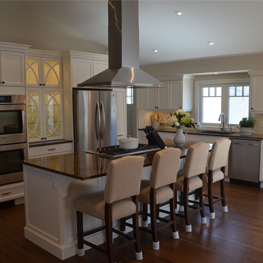
Deciding whether to renovate your home or move on to bigger and better things is one of the most stressful decisions a family can make. Our journey to ‘love it or leave it’ began over a year ago. Frustrated with our lack of entertaining space, we decided it was time to make a change. If you’re not sure whether to move or to renovate, consider whether or not your main concerns can be remedied by a renovation, or if moving is the only option. Think about your commute to work or proximity to schools, safety of your neighborhood, and square footage - there may be barriers which can’t be overcome by changing your kitchen!
We weren’t sure which was the best choice, so we gave ourselves a realistic deadline of one year to either find a new house or to renovate. With the guidance of experienced realtor, Rick Czapski, we set out to find a new home. When we moved into our home, our priorities were extra bedrooms, schools and parks nearby; now we need more room to feed and entertain our very large and still-growing family. As we visited pre-owned homes, we were able to isolate ‘must-haves,’ like an open-concept kitchen. In the end, we decided to renovate our existing home; however, looking at a wide variety of homes helped us understand what we really needed from our renovation.
 Before Renovation: Still a pretty kitchen, but walls separate it from the living room and dining room.
Before Renovation: Still a pretty kitchen, but walls separate it from the living room and dining room.
How much is too much?
When you’re planning your renovation, you need to establish which areas really need work. You may need to plan the work in stages. Think about the most valuable areas in the house - the kitchen and the bathrooms - and consider how much the value of your home will increase compared to how much you are willing to spend on a renovation.
There are many resources online to help you determine what percentage of your home value you should spend on which areas for maximum return on your investment. If your home is worth $400,000, you could reasonably spend 10 to 15 per cent or between $40,000 and $65,000 on a new kitchen. According to Rick, you can expect approximately an 80 per cent return on your kitchen investment.
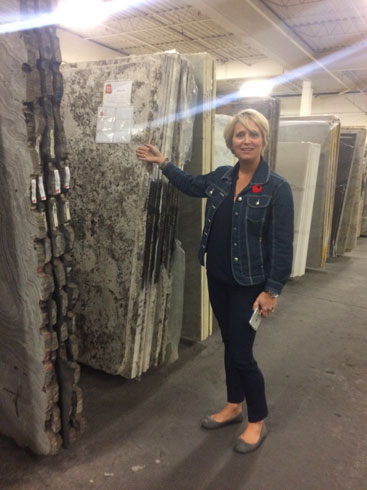
Granite shopping at Bella Pietra Surfaces with Sheri Bruneau. We started out thinking we wanted stone in these tones, but the beautiful browns and creams in a stone called Feratto won us over! Special thanks to the Pintos for their patience finding just the perfect slab.
Working with professionals
Hiring a design professional may save you a lot of time and money in the long run by helping you to avoid costly mistakes. It can be hard to visualize your space without walls or doors, especially if you’re not sure what you can and can’t remove for structural integrity. We had a good idea of what we wanted, but we knew we needed the help of a design professional to bring the plan to life. We hired Sheri Bruneau (Get It Together Inc.) who took our vision, needs and wants, and translated them into an amazing floor plan. Our wish list included an open-concept kitchen with double wall ovens, a large island with room to sit, and a butler’s pantry. That’s no small feat in a modestly-sized, mid-1970s 4-level split.
Joanda and Sue from Casa Flores Cabinetry then took Sheri’s concept plan for our kitchen and helped us create a final layout. They guided us through the selection of cabinet styles, finishes, and custom-inserts options.
There are hundreds of small and big choices to make during renovations, and it can be a huge help to have someone experienced who knows how things will look together once the space is finished - refer to your budget and decide what works best for you. Note that designers often have access to discounts and resources which are normally inaccessible!
Renovations, especially large-scale ones, are huge undertakings. While it’s possible to do some of the work yourself, consider your skill level and how much time you’re realistically willing to spend with an in-progress renovation. While it’s possible to hire each trade separately, we recommend a general contractor. A general contractor sub-contracts the trades, schedules their work, manages all the different elements of your renovation, acts as an advocate for you and a liaison between the trades, and solves problems as they arise.
“If a project’s scope of work has multiple trades involved, a contractor can be a valuable asset,” explains Adam Strong (Strong Residential Projects Ltd.). “The contractor works for the client, not his/her trades, and instils confidence in the project while addressing all customer concerns.” To ensure an accurate estimate and realistic timelines, Adam shared our plans with his team of subcontractors, who then visited our home to inspect our renovation site. This gave them the opportunity to see the scope of work and gave us the chance to meet them, ask questions, and ensure any potential problems could be solved before demolition.
Preparing for demo day
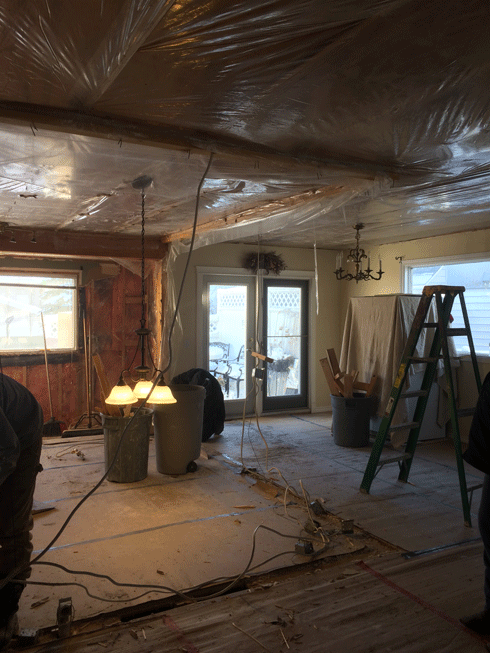 It’s important to determine where you’ll be storing your belongings while renovation is ongoing. Sheri recommends renting a storage pod, but if you choose to leave everything in the home and relocate it to another room, be aware that drywall dust gets everywhere! Consider tarping your furniture, and make sure it is secured safely to avoid little hands and feet using stacks of boxes as climbing equipment. Preferably, displaced items should be behind a closed door. Prepare to let any expectations of order go out the window - the very best we could do was keep our bedrooms clean. Tools, new appliances, and new décor items had a habit of covering any horizontal surface left unattended.
It’s important to determine where you’ll be storing your belongings while renovation is ongoing. Sheri recommends renting a storage pod, but if you choose to leave everything in the home and relocate it to another room, be aware that drywall dust gets everywhere! Consider tarping your furniture, and make sure it is secured safely to avoid little hands and feet using stacks of boxes as climbing equipment. Preferably, displaced items should be behind a closed door. Prepare to let any expectations of order go out the window - the very best we could do was keep our bedrooms clean. Tools, new appliances, and new décor items had a habit of covering any horizontal surface left unattended.
Food prep and cleaning is an often overlooked problem when your kitchen is being renovated. You will have no sink, fridge, or oven - how are you planning to ensure that everyone gets three meals a day and the dishes get washed? Can you replace large appliances with a toaster oven or bar fridge temporarily? Do you have another countertop-like surface to prep food on? Now’s a good time to cook and freeze meals ahead of time, purchase prepared meals, and/or rely on friends and family for some home-cooked meals!
School-aged children thrive on routine. Try to re-establish a ‘new normal’ during renovation - where will they study? Where will you eat as a family? When can you expect tradespeople to be in and out of the house, and where do you expect your children to be at that time? Are there any days where you aren’t allowed to stay in the house, and do you have a plan for accommodation during those times? Keep a watchful eye on the renovation schedule and make plans well in advance for yourselves and any pets in the house. (Remember, animals have sensitive lungs!)
No matter how much you hate your kitchen, there are always memories in any room you renovate. Some children are very sensitive to any change and may feel anxious about the ‘loss’ of the room they have always known, and don’t underestimate feelings of loss you may have yourself! Be sure to take lots of pictures of the house and talk about your memories together before renovations begin; hold onto small pieces of tile, growth charts on door casings, or wallpaper, if possible.
Make plans for the health and safety of your family. Tiny lungs can be quickly irritated by dust, paint fumes, and insulation. Our space was double-tarped with zippered doors to keep the worst of it out, but try to avoid spending time in the renovation zones as much as possible during sanding, painting, staining, etc. If your child tells you they are feeling sick, have a sore throat or chest, leave the house and wait for things to settle.
Budget management: “How much would it cost to add…?”
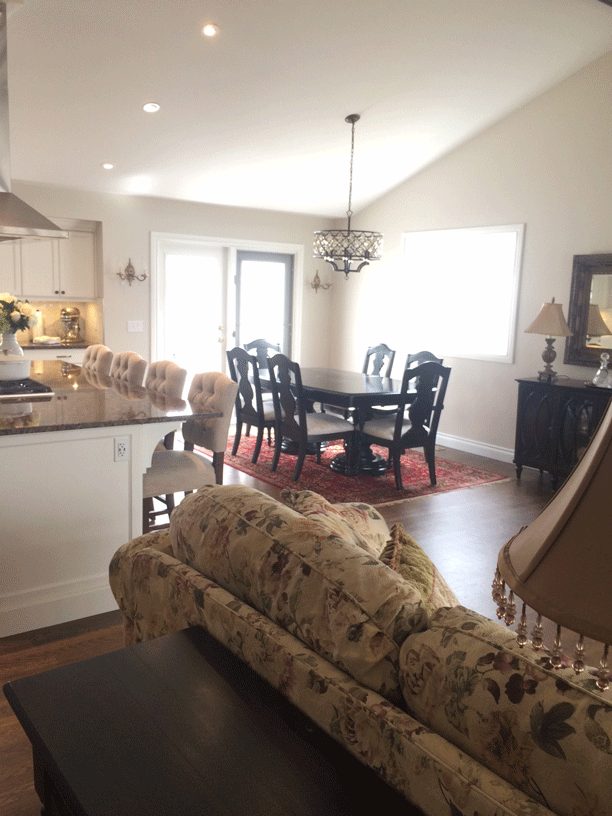 So, we didn't listen to the "resist the urge to add to the project and budget warnings and just couldn't resist adding a vault to our ceilings. We love them and for us, it was money well-spent.
So, we didn't listen to the "resist the urge to add to the project and budget warnings and just couldn't resist adding a vault to our ceilings. We love them and for us, it was money well-spent.
For us, demo day was met with mixed emotions; we were excited, but nervous about what they might find lurking in the walls (we’ve all seen that happen on design shows). Once everything is laid bare, it can suddenly feel like the sky’s the limit. It’s a blank canvas. We were warned early on to be careful of the question: “How much would it cost to add…?” because a carefully-planned and an affordable renovation can quickly spiral out of control once you start adding a little bit here and a little bit there.
If you feel that you absolutely need to add something to the plan, make sure it is something you can afford. Think back to resale value and what might help your home stand out from the others in your area, and consider that everything you add means something else may not get done.
It took eight weeks for our main floor renovation to be completed and during that time, we enjoyed watching it come together. Having a general contractor meant we never had to worry about what was getting done and when; it gave us a chance to relax and embrace the process without becoming involved in conflicts or scheduling concerns. Would we do it again? Absolutely! For us, renovation was the right choice - we didn’t want the hassle of selling our home and moving, with the potential of renovation on the other side. We’re in the home we love in the neighborhood we still enjoy.
Whether you choose to stay or go, a renovation can increase your quality of life and the resale value of your home - whenever you decide to sell.
Hiring a General Contractor
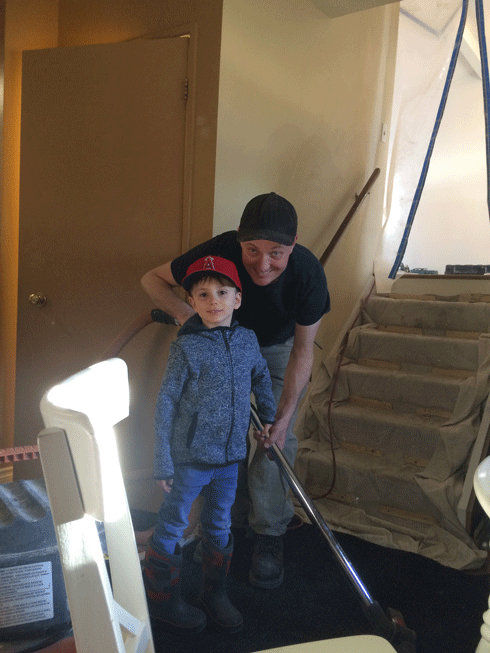
Contractor, Adam Strong visited our job site to check on progress every day. He was joined on this day with the youngest member of his team, his son Darren.
According to General Contractor, Adam Strong, of Strong Residential Projects LTD., “Contractors are required to carry liability insurance, WCB, a valid City and Provincial licence. If taking a deposit, the contractor requires a Pre-Paid Contractors Licence and cannot exceed 25 per cent upfront. All other payments should be based upon milestones (stages completed) and noted in the contract. The contract must be approved by the Provincial government and must list all details or be part of the quote. There has to be a cancellation clause noted in the contract that can be exercised within 10 days of signing the contract.
A good contractor will send all of these requirements with their initial quote or show this paperwork to the client. A potential client should ask for all of these documents along with referrals.”
Ellen is the Publisher/Editor-in-Chief of Calgary’s Child Magazine. A firm believer that chocolate should count for at least two food groups, she is happiest cooking (and eating!) in her kitchen with family and friends.
General Contractor: Adam Strong - Strong Residential Projects Ltd.
Designer: Sheri Bruneau, Get It Together Inc.
Kitchen Cabinets: Casa Flores Cabinetry
Trades:
Demolition/Framing: Timber Ridge Construction Ltd.
Drywall: Big Al’s Texture
Electrical: AAA Electrical
Furnace/HVAC: Horizon Heating
Plumbing: H & M Mechanical Ltd.
Insulation: Beyond Foam
Hardwood/Hearth Tile Installation: Floor Trendz
Granite Installation: Stoned Inc.
Painting: Prime Time Painting
Consulting Engineer: Casey Roberts
Beam: Lou Campa Construction
Materials:
Granite: Bella Pietra Surfaces
Tile: Fireplace - Deerfoot Tile, Floor Trendz
Tile: Mantle- CDL Carpets
Hardware - Top Knobs
Sink/Faucet: The En Suite
Light Fixtures: Dining Room - Robinson’s Lighting
Light Fixture Refurbish: Cartwright Lighting
Millwork: Gunther’s Building Supplies, Windsor Plywood
Appliances:
Wall Ovens/Cooktop/Rangehood: Trail Appliances, Inglewood
Calgary’s Child Magazine © 2024 Calgary’s Child